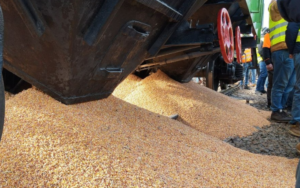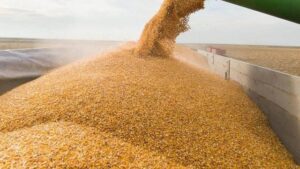
The Ukrainian Sea Corridor has transported 60 million tons of cargo in 11 months of operation, the Ukrainian Sea Ports Authority (USPA) reported on Facebook.
“60 million tons – the cargo turnover of the ports of Greater Odesa for 11 months of the Ukrainian Corridor,” the USPA said in a statement on Friday.
It is noted that 40.6 million tons of this volume are grain cargoes. They were exported to 46 countries.
“The bulk carrier Manta Hacer with 25.2 thousand tons of Ukrainian humanitarian wheat is moving through the Ukrainian corridor to Yemen. This is another vessel chartered by the UN World Food Program,” the USPA said.
The Administration emphasized that despite the war and the enemy’s insidious shelling of port infrastructure, including hangars for storing agricultural products, Ukraine remains a key player in the issue of global food security. This is especially true for grain exports to Asia and Africa.
Earlier it was reported that during the 10 months of operation of the Ukrainian Sea Corridor, cargo exports reached a record high of 55 million tons. In mid-July, it reached 57.55 million tons.

In the marketing year 2023-2024 (MY, June-July), Ukrzaliznytsia JSC (UZ) transported 35.122 million tons of grain cargo, the best figure in the last four years, said Valery Tkachev, Deputy Director of Transportation Technology and Commercial Work Department of UZ, at a meeting with agricultural market participants on Thursday.
According to him, in June, 3.48 million tons of grain were transported by rail in all directions, a third more than in the same month of 2023.
In the first six months of this year, UZ transported 21.85 million tons of grain, which is 30% more than in the same period last year.
At the same time, 2.558 million tons of grain were transported in export traffic in June, and 18.731 million tons in six months, which is 43% more than a year earlier.
Export volumes of oil and oilcake and meals also increased. Thus, in January-June 2014, 954 thousand tons of vegetable oil were transported by rail, which is 30% more than last year. During the same period, the transportation of oilcake and meal increased by 19% to 1.41 million tons, Tkachev summarized.

In January-June 2024, six Ukrainian ports increased cargo transshipment by 1.6 times compared to the same period in 2023 – up to 52.7 million tons, the Ukrainian Sea Ports Authority (USPA) reported, citing operational data.
“According to the operational data of USPA, in January-June 2024, the ports of Ukraine handled almost 52.7 million tons, compared to 31.3 million tons in 2023. Six months, six ports – 52.7 million tons,” the USPA said on Facebook on Monday.
As noted, more than half of the cargo (33.5 million tons) is agricultural products.
In June, seaports handled 6.7 million tons of cargo, which is 30% more than in June 2023. Of these, 4.1 million tons of agricultural products were exported.
According to the National Bank of Ukraine, in January-April 2024, seaports handled 35 million tons of cargo. In particular, in January – 6.3 million tons (4.4 million tons of which were agricultural products), February – 7.9 million tons (5.2 million tons), March – 6.4 million tons (4.2 million tons), April – 7.7 million tons (5.1 million tons), May – 6.7 million tons (4.5 million tons).

Since August 2023, the sea corridor created by the Ukrainian Navy has exported 55 million tons of cargo, of which more than half (37.4 million tons) were agricultural products, the Ministry of Communities, Territories and Infrastructure (MinRestore) reports.
“During the 10 months of operation of the Ukrainian Sea Corridor, a record amount of cargo was transported – 55 million tons of cargo – the cargo turnover of the ports of Greater Odesa,” the report says.
The Black Sea ports handled 1,954 thousand vessels.
Approaching the ports of Odesa, Chornomorsk and Pivdennyi are 68 vessels, exporting almost 2 million tons of cargo, the Ministry of Reconstruction said.
In early June of this year, it was reported that the sea corridor had exported 50 million tons of cargo since its launch, with 1737 vessels handled in the ports.

U.S. equipment is helping the State Border Guard Service of Ukraine and the Odesa Port Authority protect and maintain the Black Sea Humanitarian Corridor, which has so far shipped approximately 850 ships and 52 million tons of grain and cargo that will feed the world and support Ukraine’s economy, U.S. Ambassador to Ukraine Bridget Brink said.
“It’s great to be back in the thriving and courageous port city of Odesa, world-renowned for its rich cultural heritage. Even in the face of Russia’s daily attacks, Odesa stands firm on the Black Sea,” she said at the Black Sea Security Forum in Odesa.
The U.S. Ambassador said she regularly visits Odesa, meeting with local authorities, border guards, port workers and Odessans. These meetings allow her to form an idea of the problems facing the city and prove the determination of the residents to protect the city and its ports.

In January-May 2024, Ukrzaliznytsia (UZ) transported 75.4 million tons of cargo, up 30% from the same period in 2023, the UZ press service said on Monday.
About half of all cargo (38 million tons) was transported for export, which is 57% more than in January-May 2023, the report said.
“We ensure stable operation and transport commercial cargo in full. According to the results of five months, we have quite significant indicators both in total transportation volumes and in the strategic export traffic for the country. In particular, we increased grain exports by 39% compared to last year. We are ready to continue to fully meet the country’s economy and business transportation needs,” the statement quotes Yevhen Liashchenko, Chairman of the Board of UZ, as saying.
In January-May 2024, the volume of transportation in domestic traffic increased by 6.7% compared to January-May 2023 to 32.9 million tons. Cargo imports increased by 68.5% to 4.3 million tons, while exports increased by 57% to 38 million tons.
As noted, iron and manganese ore led the way in the transportation volumes for the period under review – 19.3 million tons; grain cargo – 18.8 million tons; coal – 11.5 million tons; and building materials – 10.8 million tons.
Earlier it was reported that in January-April 2024, UZ increased the volume of cargo transportation by 28.7% compared to the same period in 2023 to 59.9 million tons, while in the export direction this figure increased by 48.8% to 30.4 million tons.